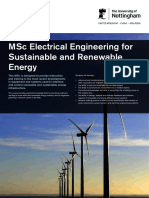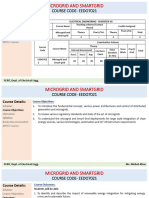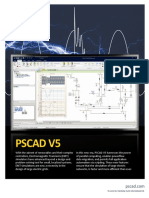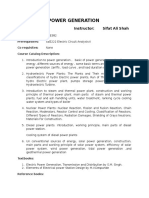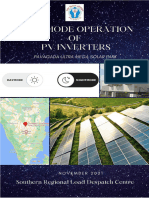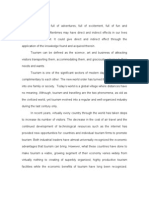EE6531: Selec
cted Topics
p
in
Smart Grid Technologies
T
Dr. Akshay K. Rathore,, Senior Member IEEE
Assistant Professor
P
Electrical and Com
mputer Engineering
National Universsity of Singapore
eleakr@nu
us edu sg
us.edu.sg
http://www.ece.nus..edu.sg/stfpage/akr
Dr. Akshay K. Rathore, Assistant Professor, Electrical and Computer Engineerring, National University of Singapore
�Module Introductio
on
7 Classes
I
Instructors:
Dr. Akshay K Rathore
R
2 lectures
Dr. Panida J 2 Lectures
A/P Dipti Sriniv
vasan 2 Lectures
A/P Ashwin Kh
hambadkone 1 Lecture
100% CA: 30% Quiz (1 quiz at
a the end of first 6 classes)
30% Seminar
40% Project (Either seminar or poster presentation competition)
Dr. Akshay K. Rathore, Assistant Professor, Electrical and Computer Engineeering, National University of Singapore
�Seminar: 1) Needs approval from one off the module lecturers.
2) The topic should be related to the module and can be based on
one or more research papers
s.
Project: 1) Research project: It could fall under following categories
b) Simulation
(a) Analysis and design; (b
(c) Experimental verificatio
on (hardware); (d) Case study
(e) Data collection and ana
alysis; (e) Novel study
2) Should choose a guide from
m module lecturers
lecturers.
3) A project report along with technical paper (max 10 pages, IEEE
double column format) nee
eds to be submitted.
submitted
4) A seminar with viva or poste
er presentation competition will be
held for final evaluation alo
ong with guide
guides
s recommendation.
3
Dr. Akshay K. Rathore, Assistant Professor, Electrical and Computer Engineeering, National University of Singapore
�Brief description of module
m
1.
2.
3.
4.
Fundamental Concepts of Smart Grid
G and Vehicular Technologies
Advanced Power Electronics Syste
y ems for Smart Grid and EV/FCV
Control, Security, and Reliability off Smart Grid
Safety and System Level Issues
Basic concepts and structures of micro
o-grid, smart grid, and vehicular
technologies.
Advanced power electronics systems and
a their control for these emerging
technologies. Power converters for sm
mart grid, electric and fuel cell
vehicles, battery management system.
Intelligent multi-agent control and cybe
er security of smart grid, system level
issues, and recent development in succh emerging technologies.
4
Dr. Akshay K. Rathore, Assistant Professor, Electrical and Computer Engineeering, National University of Singapore
�Reference Textbookss
Design of Smart Power Grid Renewa
able Energy Systems (Wiley and
IEEE): Ali Keyhani
Grid converters for Photovoltaic and Wind Power Systems (Wiley): R.
Teodorescu M
Teodorescu,
M. Liserre
Liserre, P
P. Rodrigue
ez
Integration
g
of Green and Renewable
e Energy
gy in Electric Power Systems
y
(Wiley): A. Keyhani, M. N. Marwali, M.
M Dai
*R di off research
*Reading
h papers iis hi
highl
hlly
l encouraged.
d
Dr. Akshay K. Rathore, Assistant Professor, Electrical and Computer Engineeering, National University of Singapore
�Conventional Grid
Unidirectional power flow from
f
grid to the users (load).
Possible back up at genera
ating station
No other choices for the cu
ustomers
Dr. Akshay K. Rathore, Assistant Professor, Electrical and Computer Engineeering, National University of Singapore
�Conventional Grid
What if grid fails !
Blackout !
7
Dr. Akshay K. Rathore, Assistant Professor, Electrical and Computer Engineeering, National University of Singapore
�Current utility polic
cies
cies
- Present utility system is to
o accept and feed the
placed load on line by the
e users/customers
- One way metering
- Does not accept current injection
Dr. Akshay K. Rathore, Assistant Professor, Electrical and Computer Engineeering, National University of Singapore
�Possible future utilitty policies
policies
Different rates during
g off-peak
p
((low)) and peak-hours
p
((high)
g )
Fix average load quota and utility can deny higher demand:
Possibility of Black out for custo
omer !
Accept Bidirectional Power Flow
w: Excess power generated can
be sold to the utility
1. Utility will buy at low price and sell at high price (currency
exchange)
2. Restriction on distortion in cu
urrent into the grid (standards)
3. Utility can charge if THD is above standard limits set by utility
2-way metering
Dr. Akshay K. Rathore, Assistant Professor, Electrical and Computer Engineeering, National University of Singapore
�We need back
k up
k-up
1) Storage !!!
2) Supplement energy generation
10
Dr. Akshay K. Rathore, Assistant Professor, Electrical and Computer Engineeering, National University of Singapore
�Grid-Connected Micro-Gen
neration System
y
In a grid-connected system, energy gene
erated is used locally. Surplus generated
energy is sold back to the utility service.
service
If no energy is generated, e.g., at nigh
ht, power is taken from the grid in the
conventional way.
y The g
grid is used as a ba
ack-up
p to the micro-generation
g
system
y
and
the electronics is required to perform all the
e control and switching functions.
11
Dr. Akshay K. Rathore, Assistant Professor, Electrical and Computer Engineeering, National University of Singapore
�Weather Forecast
- Renewable
Rene able energy
energ sources
so rces are
e intermittent in nat
nature
re !
With given forecast, supplementt generation without storage
may not help.
help
gy management.
Storage may help in better energ
12
Dr. Akshay K. Rathore, Assistant Professor, Electrical and Computer Engineeering, National University of Singapore
�Above Conventiona
al System
Need to set the priority based on
location.
If Load = RE Generation, Use it
L d > RE G
Load
Generation,
ti
d
draw the
th b
balance
l
powe
er from
f
Grid/Utility
G id/Utilit
Load < RE Regeneration, Option 1): Sell energ
gy to the utility and get credit for it.
Option 2): Store firstt,
t and sell if storage is full
SMART MOVE: MORE CHOICES
During off-peak hours, store the addiitional energy even if from utility
During peak hours, use the stored en
nergy or sell to the utility.
13
Dr. Akshay K. Rathore, Assistant Professor, Electrical and Computer Engineeering, National University of Singapore
�Traditional generati
g
ion
The current model for electricity generation and distribution is
dominated by centralized power plants
p
and is typically combustion
(coal, oil, and gas) or nuclear generaated.
Current substations can be anywheere from 10s to 100s of miles away
f
from
the
h actuall users off the
h power generated.
g
d This
Thi requires
i transmission
i i
across the distance.
Transmission distance issues, Greeenhouse gas emission, Production of
nuclear waste,
waste Inefficiencies an
nd power loss over the lengthy
transmission lines, Environmental distribution
d
where the power lines are
constructed,, and securityy related issuues.
14
Dr. Akshay K. Rathore, Assistant Professor, Electrical and Computer Engineeering, National University of Singapore
�Distributed generat
g
tion
Distributed generation (DG) em
mploys small-scale technologies to
produce electricity close to the end users.
u
Distributed generators can provide lower-cost electricity and higher
power reliability and security withh fewer environmental consequences
than
h traditional
di i l power generators.
DG systems employ numerous, butt small plants and can provide power
onsite with little reliance on the disttribution and transmission grid.
DG technologies yield power in cappacities that range from a fraction of
a kilowatt [kW] to about 100 megaw
watts [MW].
15
Dr. Akshay K. Rathore, Assistant Professor, Electrical and Computer Engineeering, National University of Singapore
�Advanced Energy System
Power Electronics systems
y
work in conjunction
j
with distributed energy
gy
resources to convert harvested ene
ergy into useable electrical power.
16
Dr. Akshay K. Rathore, Assistant Professor, Electrical and Computer Engineeering, National University of Singapore
�Fuel Cells Systtem
PV, Wind are free of cosst but their output is
dependent on weather, season
s
etc.
Output
p is unsecure.
Fuel cell output is secure
e It can maintain continuity
e.
of power as long as fuel supply is resumed.
Typical PV efficiency < 20%,
2
while Fuel cell
efficienc is ttypically
efficiency
picall 40%
% and combined with
ith
generated heat makes itt up to 70%.
17
Dr. Akshay K. Rathore, Assistant Professor, Electrical and Computer Engineeering, National University of Singapore
�Energy Storage
Battery: Disposal Issues, Leakage,
L
Capacity
dependent on season, lifetime issues based on deep
di h
discharge,
charging
h i and
d discharging
h i cycles
l
Gas (Hydrogen and Oxyge
en): Stored in cylinders
No issues at all like leakag
ge, lifetime, season
dependent capacity, dispo
osal etc.
Needs electrolyser and op
pens scope for electrolyser
industries.
18
Dr. Akshay K. Rathore, Assistant Professor, Electrical and Computer Engineeering, National University of Singapore
�What do we mean byy Smart:
Conventional meanings
1) Good looking
2) Fancy
3) Different from conventional
True meaning: Intelligent
ptimal decisions
Decision making ability: make op
Calculation: mathematical calculation/optimization
he decision message
g to right
g
Communication: communicate th
agent/object
g
skills: Energy
gy flow ((direction)) management
g
Management
19
Dr. Akshay K. Rathore, Assistant Professor, Electrical and Computer Engineeering, National University of Singapore
�Smart Grid (1/3)
anelectricalgridthatusesinform
mationandcommunications
technologiestodetermineandacttinanautomatedfashion
toimprovetheefficiency,reliabil
to
improve the efficiency reliability,economics,andsustainability
ity economics and sustainability
oftheproductionanddistribution
nofelectricity.
anetworkofgridswithgridtogridintegration.
20
Dr. Akshay K. Rathore, Assistant Professor, Electrical and Computer Engineeering, National University of Singapore
�Smart Grid (2/3)
Smart Metering
- two way communication
- secure wireless network techno
ology
21
Dr. Akshay K. Rathore, Assistant Professor, Electrical and Computer Engineeering, National University of Singapore
�Smart Grid (3/3)
22
Dr. Akshay K. Rathore, Assistant Professor, Electrical and Computer Engineeering, National University of Singapore
�Components of Smart Grid
Grid
External source(s), i.e., re
enewable energy source(s)
Storage and/or vehicle
Power electronics
Sensors and network
Communication and conttrol
Smart
S
meter (two-way)
(
)
Displayy unit
23
Dr. Akshay K. Rathore, Assistant Professor, Electrical and Computer Engineeering, National University of Singapore
�Need of Smart Grid
- Meet the increasing globa
al energy demand while
maintaining public comfort.
- Reduce carbon emission, i.e.,
i e pollution
- Save the earth/environme
ent/atmosphere
- Restore green and clean nature
24
Dr. Akshay K. Rathore, Assistant Professor, Electrical and Computer Engineeering, National University of Singapore
�What Smart Grid ha
as to Offer
Offer
- More choices to the userss to choose from
- Flexibility
- Comfort and luxury
25
Dr. Akshay K. Rathore, Assistant Professor, Electrical and Computer Engineeering, National University of Singapore
�Motivation for Innov
vation
Energy Saving
Saving, ii.e.
e optiimal utilization
Continuity of Electric Po
ower
Less dependency on uttility
Reduced electricityy bill
More choices to the use
er/customer
Sustainable
S t i bl and
d comfo
f rtable
t bl liliving
i
26
Dr. Akshay K. Rathore, Assistant Professor, Electrical and Computer Engineeering, National University of Singapore
�Motivation for Innov
vation
Low carbon mobility
Reduced noise and air po
ollution
Social, Economic, Environ
nmental, and Health
benefits
Meeting the global energyy demand at reasonable
price rate, knowing
p
g fast de
epletion
p
of fossil fuel and
increasing electricity price
e
Green Energy and Clean Transportation
27
Dr. Akshay K. Rathore, Assistant Professor, Electrical and Computer Engineeering, National University of Singapore
�Hybrid Grid Conc
cept
Standard AC grid
(230 V, 50 Hz))
Low voltage DC grid (24 V)
DC voltage grid
(350 380 V)
Domestic load is DC and can be fed
d through 24 V.
V
Industrial dc load can be fed througgh 350 V or through 350 V and 24 V
dc grid.
grid
Eliminated the needs of ac/dc conveerters, i.e., adapters, etc. because the
form of renewable generation is DC
C.
28
Dr. Akshay K. Rathore, Assistant Professor, Electrical and Computer Engineeering, National University of Singapore
�Merits of DC Grid
Most of the residential/domesticc load is of DC type.
yp
Lighting, Fan (PMLDC motor ba
ased), Computer, Laptop,
TV, Display
p y Units, Washing
g Macchines etc.
Most of the residential load is th
hrough DC but fed type
standard AC supply.
It involves AC/DC rectifier (power conversion) unit with
each load.
It introduces energy loss and distorts the utility current
waveform.
Better energy utilization.
29
Dr. Akshay K. Rathore, Assistant Professor, Electrical and Computer Engineeering, National University of Singapore
�Role of Power Elec
ctronics
- Regulation; needed due to intermitttent nature of renewables
- Power
P
conditioning;
diti i
needed to ch
hange the electric form
- Interfacing of sources and loa
ads; match the nature,
renewable/storage to grid integration
30
Dr. Akshay K. Rathore, Assistant Professor, Electrical and Computer Engineeering, National University of Singapore
�Summary
---
31
Dr. Akshay K. Rathore, Assistant Professor, Electrical and Computer Engineeering, National University of Singapore
�Q(s) & A(s)
32
Dr. Akshay K. Rathore, Assistant Professor, Electrical and Computer Engineeering, National University of Singapore






















